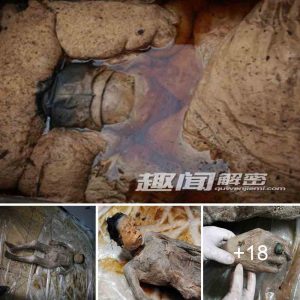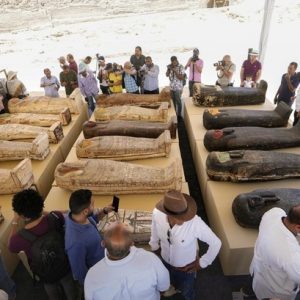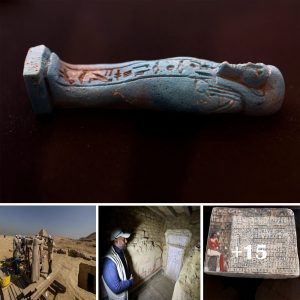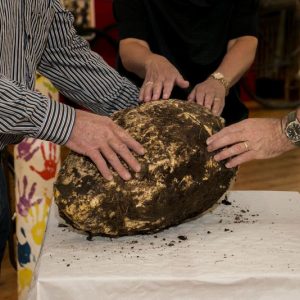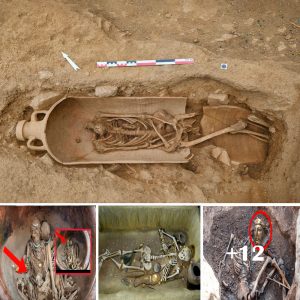
In a breathtaking revelation that defies the boundaries of Egyptian archaeology, CT scans of an Egyptian mummy dating back to approximately 1,200 BC have unearthed a mortuary treatment previously undocumented in the annals of history. Prepare to be captivated as we embark on a journey of rediscovery, as the veil is lifted on the remarkable existence of the first known instance of an ancient Egyptian ‘mud mummy.’ This extraordinary find has compelled archaeologists to reassess their preconceived notions about the preservation practices employed by nonroyal ancient Egyptians to honor their departed loved ones.

Leading the charge in unraveling this enthralling enigma is Karin Sowada, a charismatic figure hailing from Macquarie University in Sydney, Australia. With her pioneering spirit and magnetic allure, Sowada has spearheaded the analysis of this unnamed, mummified adult, solidifying her role as the lead author in a groundbreaking study recently published in the prestigious journal PLOS ONE. The words leap off the page as the researchers proclaim in their seminal paper that the CT scan has unveiled an awe-inspiring revelation—the mummified individual was found to be “fully sheathed in a mud shell or carapace.”
Immerse yourself in the illustrious realm of the Nicholson Collection, housed within the revered Chau Chak Wing Museum at the esteemed University of Sydney, where the mummified individual and its accompanying coffin stand as mesmerizing artifacts. A. Behold the mummified individual, delicately encased within a modern sleeve, a testament to the meticulous efforts of preservation. B. Gaze upon the ornate coffin lid, a masterpiece reflecting the skilled craftsmanship of ancient Egypt. The visual tapestry transports us to a bygone era, enchanting us with its silent whispers of a forgotten past.

Live Science reports that this enigmatic mummy, along with its lidded coffin and mummy board—a wooden cover placed over the body—was acquired by Sir Charles Nicholson, a renowned English-Australian politician, during his transformative expedition to Egypt in 1856-1857. Since 1860, this extraordinary assemblage has graced the halls of the Chau Chak Wing Museum. However, it was not until the advent of computed tomography (CT) scanning that the mummy’s unique mud shell came to light. Astonishingly, the “carapace,” ingeniously concealed within layers of linen wrappings, had remained concealed from the prying eyes of explorers until this recent breakthrough.

In 1999, Sowada and her dedicated team embarked on an awe-inspiring odyssey, conducting a comprehensive CT scan of the mummified body. Driven by an insatiable thirst for knowledge, they resolved to revisit their findings in 2017, leveraging state-of-the-art technology for a fresh perspective. And what wonders awaited them! A trove of surprises emerged, breathing new life into their research. And now, at long last, these breathtaking discoveries are unveiled, captivating us with their revelations.

Behold the captivating images captured through the prism of CT scans, revealing the mummified person from various angles. A thin white line, resembling a delicate filament, delineates the mud carapace that enshrouds the body, inviting our imaginations to run wild. (Sowada et al. Courtesy Chau Chak Wing Museum and Macquarie Medical Imaging / PLOS ONE/ CC BY 4.0)
The scans, first and foremost, unveiled the presence of the mud carapace enveloping the entire body. As fragments of the mud shell were carefully extracted from the cranial region, the researchers made a startling revelation—it consisted of three distinct layers. The foundation comprised a slender layer of mud, coated with a white.
Finally, the researchers mention that there are some ambiguous examples of shells being used in the mortuary process for “mummified bodies of lesser status” but “The mud shell encasing the body of a mummified woman within the textile wrappings is a new addition to our understanding of ancient Egyptian mummification .” No one knows for certain yet how popular this process may have been in the funerary practices of everyday people during the late New Kingdom of ancient Egypt.
